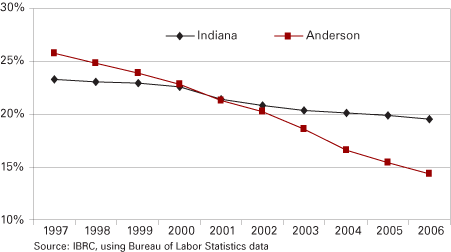Anderson
Professor of Economics, Falls School of Business, Anderson University
Employment is a central issue for the city of Anderson and Madison County. More specifically, for more than sixty years, automotive manufacturing employment has been the center of our economic base. After twenty-five years of decline, however, the automotive manufacturing industry has finally closed its doors on Anderson.
Due primarily to the decline in the auto industry, employment in Madison County has been falling over recent years. Ten years ago, there were 47,488 jobs in the county, with 12,246 of these jobs in manufacturing. As recently as 2006, there were 41,225 jobs in the county and only 5,901 of them were in manufacturing. Those figures translate into a 13 percent decrease in overall employment and a 52 percent decrease in manufacturing employment. Figure 1 shows manufacturing as a percent of total nonfarm employment in Anderson and Indiana since 1997. No employment categories in the area show significant gains over the past four years. Consequently, unemployment in the city and the county is running far above normal. From January to August 2007, unemployment in the county averaged 6.9 percent while unemployment in the city of Anderson was 7.8 percent.
Figure 1
Manufacturing as a Percent of Total Nonfarm Employment, 1997 to 2006

The decline in employment has led to declines in other areas that measure the economic condition of the community. Income levels are lagging behind the rest of Indiana. Average earnings in Madison County for 2006 are only 88 percent of average earnings for the state. The housing market has shown the impact of both local and national turmoil. The number of housing permits issued last year fell to only 328 for the county. This number is far below historic averages. In addition, the industrial tax base has been falling, causing residential property taxes to rise. On another measure, population projections indicate a declining population for the county.
The problem with relying on these types of statistics as diagnostic tools is that they represent too much of the past and not enough of the future of Anderson. The current numbers now only serve to set a benchmark for the Anderson of the future.
The Anderson of the past is behind us, and the city of Anderson is being redefined. For the first time in decades, the people of Anderson have the opportunity to create the Anderson they want without interference from auto industry leaders in Michigan.
Recreating Anderson does have its obstacles. The auto industry left us with an economic and cultural legacy that must change. Auto industry jobs paid well and didn't require much education. We must now build a culture of education in our city.
The consolidation of the high schools into two schools and the recent construction of new school buildings are certainly positive moves for the city. The creation and retention of a workforce prepared for the twenty-first century is of paramount importance. Currently, only 14 percent of the adult population (twenty-five years of age or older) in Madison County has a bachelor's degree or higher. That number is particularly low compared to the rest of the state, where 22 percent of adults hold degrees in higher education. Improvement in the local school system should help increase the demand for housing, which is another obstacle to recreating Anderson.
The county has two immediate and simultaneous problems with the housing market—housing values are falling and property taxes are rising. People want to live where the purchase of a home is also an investment opportunity. They also want reasonable property taxes that reflect the level of public services provided to the community. With the falling industrial tax base and rising residential property taxes, restoring the industrial/commercial tax base and increasing the demand for housing are two important obstacles to overcome.
The biggest challenge facing Madison County is the ability to attract/create new jobs for the community. Mayor Kevin Smith's administration has shown an aggressive approach to recruiting employers into the area. The city has made new investment in its infrastructure. Older, unused buildings are being removed, improving the landscape of Anderson. The recent commitments from Nestlé and IBM are a reflection of those efforts. Not only do these additions bring new jobs to the area, but they are a source of additional business leadership for the community.
The county's strengths should help to overcome these obstacles. The creation of the Flagship Enterprise Center provides an opportunity for local companies and entrepreneurs to pursue their creativity and create jobs in the process. Recent recognitions from the Rotary, Forbes Magazine, and the Indiana Chamber of Commerce are a reflection of the potential strength of the city's leadership. When aggressively marketed, these types of awards can add to the attractiveness of the city and provide an important attraction tool to bring in potential employers. Aggressive leadership can take advantage of these types of positive recognition to help move Anderson forward. The actions that we take now will help to create a new Anderson University in the years to come.
It isn't the trends of past data that tell us much about the new Anderson. Understanding the new Anderson requires a forward type of vision and not a backward one.
Also in this Issue…
- Outlook for 2008
- The International Economy
- The U.S. Economy
- Financial Forecast
- Housing
- Indiana Agriculture
- Indiana
- Anderson
- Bloomington
- Columbus
- Evansville
- Fort Wayne
- Gary
- Indianapolis-Carmel
- Kokomo
- Louisville
- Muncie
- Richmond
- South Bend-Mishawaka and Elkhart-Goshen
- Terre Haute
- Return to Table of Contents



